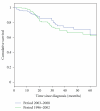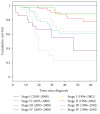Changing trends of breast cancer survival in sultanate of oman
- PMID: 20981261
- PMCID: PMC2964035
- DOI: 10.1155/2011/316243
Changing trends of breast cancer survival in sultanate of oman
Abstract
Breast cancer is the leading cause of cancer-associated mortality in women, with elevated incidence in developing countries. This retrospective study included all 122 patients diagnosed with breast cancer from January 2003 to December 2008 in the Sultanate of Oman. Age at presentation was 47.41 years (SD±12.88), with one-third of patients younger than 40 years. The majority of patients presented with stage III (41.2%) and IV (18.2%) breast cancer. T size (P = .023), skin involvement (P = .003), and stage at presentation (P = .004) were significantly associated with overall survival. Skin involvement at presentation (P = .003), T size (P = .09), lymph node status (P = .013), and stage (P = .003) were strong predictors of relapse-free survival. Patients had a 5-year survival of 78%, compared to 64% of breast cancer patients diagnosed between 1996 and 2002 identified in our previously published study. Thus, despite Omani breast cancer patients continuing to present with advanced breast cancer, survival rates have significantly improved.
Figures
References
-
- Al-Moundhri A, Al-Bahrani B, Pervez I, et al. The outcome of treatment of breast cancer in a developing country—Oman. Breast. 2004;13(2):139–145. - PubMed
-
- Aziz Z, Iqbal J, Akram M. Predictive and prognostic factors associated with survival outcomes in patients with stage I-III breast cancer: a report from a developing country. Asia-Pacific Journal of Clinical Oncology. 2008;4(2):81–90.
-
- Badar F, Faruqui ZS, Ashraf A, Uddin N. Third world issues in breast cancer detection. Journal of the Pakistan Medical Association. 2007;57(3):137–140. - PubMed
-
- Raina V, Bhutani M, Bedi R, et al. Clinical features and prognostic factors of early breast cancer at a major cancer center in North India. Indian Journal of Cancer. 2005;42(1):40–45. - PubMed
-
- Aziz Z, Sana S, Akram M, Saeed A. Socioeconomic status and breast cancer survival in Pakistani women. Journal of the Pakistan Medical Association. 2004;54(9):448–453. - PubMed
LinkOut - more resources
Full Text Sources



